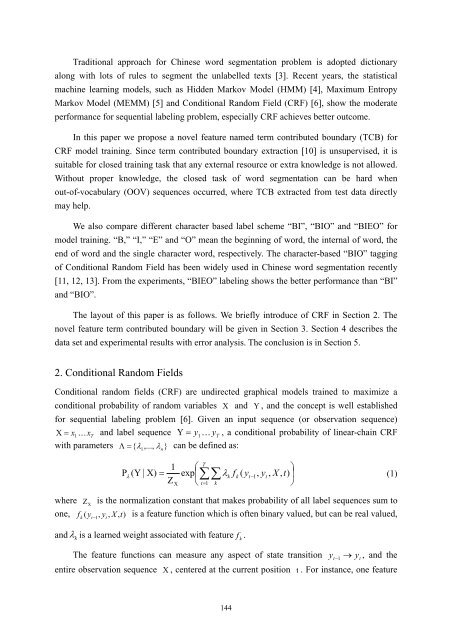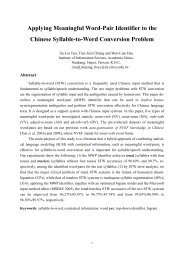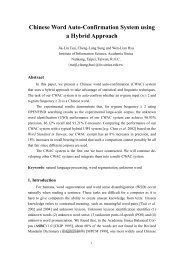Term Contributed Boundary Feature using ... - Academia Sinica
Term Contributed Boundary Feature using ... - Academia Sinica
Term Contributed Boundary Feature using ... - Academia Sinica
Create successful ePaper yourself
Turn your PDF publications into a flip-book with our unique Google optimized e-Paper software.
Traditional approach for Chinese word segmentation problem is adopted dictionary<br />
along with lots of rules to segment the unlabelled texts [3]. Recent years, the statistical<br />
machine learning models, such as Hidden Markov Model (HMM) [4], Maximum Entropy<br />
Markov Model (MEMM) [5] and Conditional Random Field (CRF) [6], show the moderate<br />
performance for sequential labeling problem, especially CRF achieves better outcome.<br />
In this paper we propose a novel feature named term contributed boundary (TCB) for<br />
CRF model training. Since term contributed boundary extraction [10] is unsupervised, it is<br />
suitable for closed training task that any external resource or extra knowledge is not allowed.<br />
Without proper knowledge, the closed task of word segmentation can be hard when<br />
out-of-vocabulary (OOV) sequences occurred, where TCB extracted from test data directly<br />
may help.<br />
We also compare different character based label scheme “BI”, “BIO” and “BIEO” for<br />
model training. “B,” “I,” “E” and “O” mean the beginning of word, the internal of word, the<br />
end of word and the single character word, respectively. The character-based “BIO” tagging<br />
of Conditional Random Field has been widely used in Chinese word segmentation recently<br />
[11, 12, 13]. From the experiments, “BIEO” labeling shows the better performance than “BI”<br />
and “BIO”.<br />
The layout of this paper is as follows. We briefly introduce of CRF in Section 2. The<br />
novel feature term contributed boundary will be given in Section 3. Section 4 describes the<br />
data set and experimental results with error analysis. The conclusion is in Section 5.<br />
2. Conditional Random Fields<br />
Conditional random fields (CRF) are undirected graphical models trained to maximize a<br />
conditional probability of random variables<br />
X<br />
and Y , and the concept is well established<br />
for sequential labeling problem [6]. Given an input sequence (or observation sequence)<br />
X = x 1<br />
Kx T<br />
and label sequence Y = y 1<br />
K yT<br />
, a conditional probability of linear-chain CRF<br />
with parameters Λ = λ ,..., λ } can be defined as:<br />
where<br />
one,<br />
Z X<br />
{ 1 n<br />
T<br />
1 ⎛<br />
⎞<br />
Pλ (Y | X) = exp⎜∑∑λk<br />
fk<br />
( yt−<br />
1,<br />
yt<br />
, X , t)<br />
⎟<br />
(1)<br />
ZX<br />
⎝ t=<br />
1 k<br />
⎠<br />
is the normalization constant that makes probability of all label sequences sum to<br />
f k<br />
(y t−<br />
1,<br />
yt<br />
, X , t)<br />
is a feature function which is often binary valued, but can be real valued,<br />
and λ is a learned weight associated with feature .<br />
k<br />
The feature functions can measure any aspect of state transition<br />
entire observation sequence<br />
f k<br />
y<br />
→<br />
t −1<br />
y t<br />
, and the<br />
X , centered at the current position t . For instance, one feature




